Related Research Articles
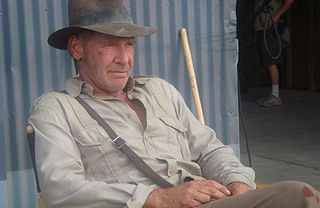
Dr. Henry Walton "Indiana" Jones, Jr. is the title character and protagonist of the Indiana Jones franchise. George Lucas created the character in homage to the action heroes of 1930s film serials. The character first appeared in the 1981 film Raiders of the Lost Ark, to be followed by Indiana Jones and the Temple of Doom in 1984, Indiana Jones and the Last Crusade in 1989, The Young Indiana Jones Chronicles from 1992 to 1996, Indiana Jones and the Kingdom of the Crystal Skull in 2008, and Indiana Jones and the Dial of Destiny in 2023. The character is also featured in novels, comics, video games, and other media. Jones is also the inspiration for several Disney theme park attractions, including Indiana Jones and the Temple of Peril, the Indiana Jones Adventure, and Epic Stunt Spectacular! attractions.

Lucasfilm Games is an American video game licensor and a subsidiary of Lucasfilm. It was founded in May 1982 by George Lucas as a video game development group alongside his film company; as part of a larger 1990 reorganization of the Lucasfilm divisions, the video game development division was grouped and rebranded as part of LucasArts. LucasArts became known for its line of adventure games based on its SCUMM engine in the 1990s, including Maniac Mansion, the Monkey Island series, and several Indiana Jones titles. A number of influential game developers were alumni of LucasArts from this period, including Brian Moriarty, Tim Schafer, Ron Gilbert, and Dave Grossman. Later, as Lucasfilm regained control over its licensing over the Star Wars franchise, LucasArts produced numerous action-based Star Wars titles in the late 1990s and early 2000s, while dropping adventure game development due to waning interest in the genre.

Monkey Island is a series of adventure games. The first four games were produced and published by LucasArts, earlier known as Lucasfilm Games. The fifth was developed by Telltale Games with LucasArts, while the sixth was developed by Terrible Toybox with Lucasfilm Games and Devolver Digital.
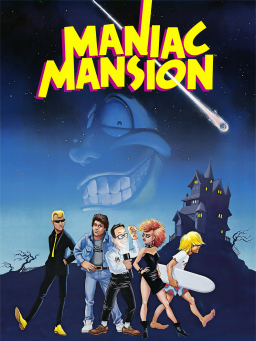
Maniac Mansion is a 1987 graphic adventure video game developed and published by Lucasfilm Games. It follows teenage protagonist Dave Miller as he attempts to rescue his girlfriend Sandy Pantz from a mad scientist, whose mind has been enslaved by a sentient meteor. The player uses a point-and-click interface to guide Dave and two of his six playable friends through the scientist's mansion while solving puzzles and avoiding dangers. Gameplay is non-linear, and the game must be completed in different ways based on the player's choice of characters. Initially released for the Commodore 64 and Apple II, Maniac Mansion was Lucasfilm Games' first self-published product.

RuneQuest is a fantasy tabletop role-playing game originally designed by Steve Perrin, Ray Turney, Steve Henderson, and Warren James, and set in Greg Stafford's mythical world of Glorantha. It was first published in 1978 by The Chaosium. Beginning in 1984, publication passed between a number of companies, including Avalon Hill, Mongoose Publishing, and The Design Mechanism, before finally returning to Chaosium in 2016. RuneQuest is notable for its system, designed around percentile dice and an early implementation of skill rules, which became the basis for numerous other games. There have been several editions of the game.

Sam & Max is an American media franchise about Sam and Max, a pair of anthropomorphic vigilante private investigators. The characters, who occupy a universe that parodies American popular culture, were created by Steve Purcell in his youth, and later debuted in a 1987 comic book series. The characters have since been the subject of a graphic adventure video game developed by LucasArts, a television series produced for Fox in cooperation with Nelvana Limited, and a series of episodic adventure games developed by Telltale Games. In addition, a variety of machinima and a webcomic have been produced for the series.
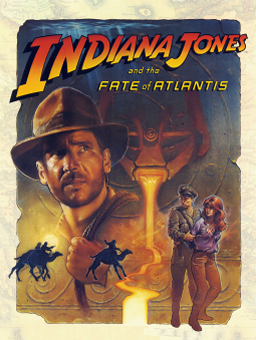
Indiana Jones and the Fate of Atlantis is a point-and-click adventure game developed and published by LucasArts and released in June 1992 for Amiga, DOS, and Macintosh. Almost a year later, it was reissued on CD-ROM as an enhanced "talkie" edition with full voice acting and digitized sound effects. The seventh game to use the script language SCUMM, Fate of Atlantis has the player explore environments and interact with objects and characters by using commands constructed with predetermined verbs. It features three unique paths to select, influencing story development, gameplay and puzzles. The game used an updated SCUMM engine and required a 286-based PC, although it still runs as a real-mode DOS application. The CD talkie version required EMS memory enabled to load the voice data.
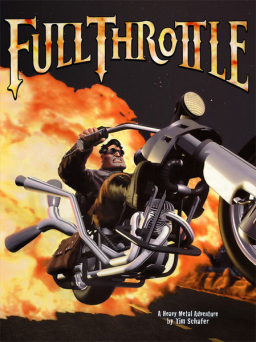
Full Throttle is a 1995 graphic adventure video game developed by LucasArts and designed by Tim Schafer. It was Schafer's first game as project lead and head writer and designer, after having worked on other LucasArts titles including The Secret of Monkey Island (1990), Monkey Island 2: LeChuck's Revenge (1991), and Day of the Tentacle (1993). Set in the near future, the story follows motorcycle gang leader Ben, who must clear his name after being framed for the murder of a beloved motorcycle manufacturing mogul. A remastered version of the game was developed by Double Fine Productions and was released in April 2017 for Windows, PlayStation 4 and PlayStation Vita, with later ports for iOS and Xbox One.
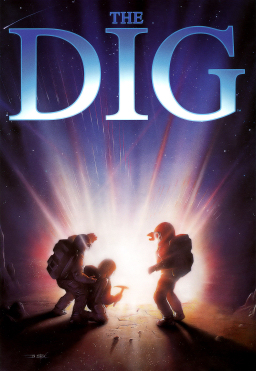
The Dig is a 1995 point-and-click adventure game developed by LucasArts for PC and Macintosh. Like other LucasArts adventure games, it uses the SCUMM video game engine. It features a full voice-acting cast, including voice actors Robert Patrick and Steve Blum, and a digital orchestral score. The game uses a combination of drawn two-dimensional artwork and limited, pre-rendered three-dimensional clips, with the latter created by Industrial Light & Magic.
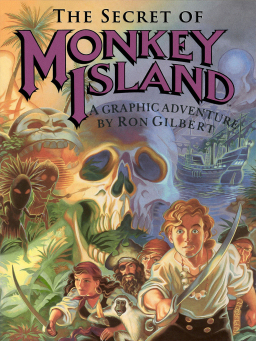
The Secret of Monkey Island is a 1990 point-and-click graphic adventure game developed and published by Lucasfilm Games. It takes place in a fictional version of the Caribbean during the age of piracy. The player assumes the role of Guybrush Threepwood, a young man who dreams of becoming a pirate, and explores fictional islands while solving puzzles.

Monkey Island 2: LeChuck's Revenge is an adventure game developed and published by LucasArts in 1991. A sequel to 1990's The Secret of Monkey Island, it is the second game in the Monkey Island series. It was the sixth LucasArts game to use the SCUMM engine, and the first game to use the iMUSE sound system. In it, pirate Guybrush Threepwood searches for the legendary treasure of Big Whoop and again faces off against the pirate LeChuck, who is now an undead corpse.

Steven Ross Purcell is an American cartoonist, animator, game designer and voice actor. He is the creator of the media franchise Sam & Max, for which Purcell received an Eisner Award in 2007. The series has grown to incorporate an animated television series and several video games.
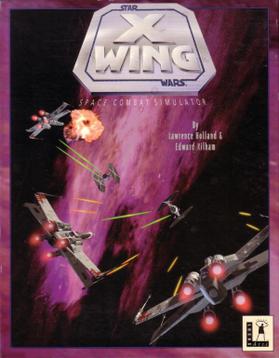
Star Wars: X-Wing is a space simulation video game, the first of the X-Wing combat flight simulation games series. The player's character flies starfighters, including the X-wing, for the Rebel Alliance. The narrative precedes and parallels the events of Star Wars Episode IV: A New Hope.
Grenadier Models Inc. of Springfield, Pennsylvania produced lead miniature figures for wargames and role-playing games with fantasy, science fiction and heroic themes between 1975 and 1996. Grenadier Models Inc. is best known for their figures for TSR, Inc.'s Advanced Dungeons & Dragons game, collectible Dragon-of-the-Month and Giants Club figures, and their marketing of paint and miniature sets through traditional retail outlets.
Adventurers Guild was a closed-end, computer-moderated, role-playing play-by-mail (PBM) game. It was available as early as mid-1990 by the publisher, Entertainment Plus More, Inc. Multiple reviewers thought it similar to the PBM game Duelmasters, while reviewer Gordon Blair thought it better than similar games. The game received various reviews in gaming magazines in the 1990s, ranging from poor to positive.
Indiana Jones is an American media franchise consisting of five films and a prequel television series, along with games, comics, and tie-in novels, that depicts the adventures of Dr. Henry Walton "Indiana" Jones, Jr., a fictional professor of archaeology.

MegaTraveller 1: The Zhodani Conspiracy is a 1990 space science fiction role-playing video game based on the Traveller series and was produced by Game Designers' Workshop licensee Paragon Software for Amiga, Atari ST, and MS-DOS. The game is set within the Official Traveller Universe and features character creation and other aspects of game mechanics compatible with prior Traveller products. The player controls up to five ex-military adventurers whose objective is to save their civilization, the Imperium, from a conspiracy instigated by the Zhodani, a rival spacefaring race, and aided by the actions of a traitor named Konrad Kiefer. Gameplay features real-time planetary and space exploration, combat, trading, and interaction with various non-player characters in eight solar systems containing twenty-eight visitable planets.
Gary Winnick is an American computer game designer, writer, artist, and animator who was the first artist hired by Lucasfilm Games. He co-designed Maniac Mansion, alongside Ron Gilbert, and created the comic book Bad Dreams.

Adventurers Club was a quarterly magazine published by Hero Games and edited at various times by Steve Peterson, Bill Robinson and Bruce Harlick. It was started in 1983 and ceased publication in 1995. In total 27 issues were published.
References
- ↑ "The Adventurer, Issue No. 1 (Fall, 1990)". Lucasarts Adventurer. Retrieved 20 March 2016.
- ↑ "The Adventurer". The Adventurer (1). Lucasfilm Games: 8. 1990.
- ↑ "The Adventurer (intro)". LucasArts. Archived from the original on 13 February 1998.